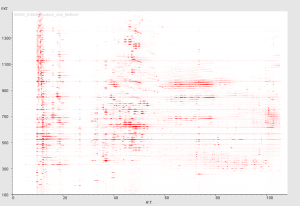Plant Metabolome Repository provides information about compound peaks detected by liquid chromatography (LC) – mass spectrometry (MS)-based untargeted metabolome analysis of various plants. This is a sister website of Food Metabolome Repository.
Feature 1: Search by mass and retention time
Sample specific localization of a peak in various plants can be queried by the accurate mass value detected and the retention time of LC. Especially in case of an unknown peak, it’s sample-specific localization would help researchers to prioritize the unknown for further detailed investigation and identification spending a large cost.
As a uniform analytical method is applied for all samples in this website and also in Food Metabolome Repository, retention time is also comparable in a narrow margin (approx. in 3 min).
Feature 2: Search by mass spectrum
A mass spectra is a set of multiple ions with mass values and their intensity. The peaks with mass spectra that are similar to the queried mass spectrum can be searched. Not only MS2 (MS/MS) spectra but also MS3 spectra are available for intense peaks. This should be useful in such cases that finding glycosylated derivatives of a common aglycone.
*Note: MS2 and MS3 spectra are not available for all peaks.
Feature 3: MassChroBook
A two-dimensional mass chromatogram is available in a PowerPoint file.
This representation helps to grasp a difference of the overview of metabolome profiles between the samples.

Feature 4: API
A set of application programming interface (API) which enables computational access to the search and acquiring functions of this website is available. This facilitates bioinformatic researchers to perform an automatic search of a large number of queries and further compilation of data. See Help - APIs for the details.
Feature 5: Estimation of N and S atom numbers
For some samples, the estimated number of nitrogen (N) and sulfur (S) were attached to the peak information. These were estimated using the plants grown with stable isotope labeled fertilizer. These information and peak search function will be useful for annotation of the unknown peaks.
Analytical Methods
All samples were analyzed by a uniform method that is suitable for detecting metabolites with molecular weights ranged from 100 to 1500 Da and with medium polarity. Volatiles, highly-hydrophobic compounds and highly-hydrophilic compounds are not expected to be detected in the condition. The metabolites were extracted in methanol, separated by reversed-phase liquid chromatography using a C18 column and water-acetonitrile solvents, and detected using high-resolution mass spectrometry in positive and negative modes in electrospray ionization. MS2 and MS3 spectra were obtained for compounds detected with higher intensities.
The results of a compound database search using the measured accurate mass value were attached to the peak information. Also, the predicted flavonoid aglycones which were obtained using measured MS2/MS3 spectra and the FlavonoidSearch system (Akimoto et al., 2017) were attached. Method details are available at the Help page.
- It is not guaranteed that the compounds listed for the peak are present in the sample.
- It is not guaranteed that the compounds not listed for the peak are absent in the sample.
Related website
| Food Metabolome Repository | |
| Thing Metabolome Repository |
 Share peaks and spectra!
Share peaks and spectra!
When you find curious peaks or spectra, let's tweet the URLs for the peaks or searches, and share them with us!
Someone may give you wonderful annotations...
Please follow me @shokurepo4